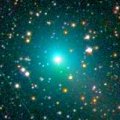
|
Now it is so bright as 7.9 mag (May 5, Juan Jose Gonzalez). It will be observable at 8-9 mag in good condition from April to May. After that, it keeps observable for a long time until when it fades out in the Northern Hemisphere, although it will be low in July.
Date(TT) R.A. (2000) Decl. Delta r Elong. m1 Best Time(A, h)
May 8 21 57.37 76 45.3 1.408 1.427 70 8.4 5:15 (186,-23)
May 15 0 12.22 82 13.8 1.510 1.439 66 8.6 5:19 (187,-30)
|
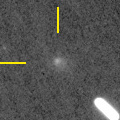
|
It has been unobservable for a while, but now it is appearing in the morning sky. Now it is 10.0 mag, much brighter than originally expected (Apr. 25, Marco Goiato). It will approach to the sun down to 0.4 A.U. in July, and it is expected to reach up to 2-3 mag. In the Northern Hemisphere, it is observable only until June.
Date(TT) R.A. (2000) Decl. Delta r Elong. m1 Best Time(A, h)
May 8 23 45.46 12 30.0 1.783 1.318 46 9.2 5:15 (236, 22)
May 15 0 5.02 17 40.5 1.611 1.193 47 8.5 5:19 (230, 20)
|
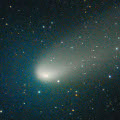
|
It reached up to 9.2 mag in March (Mar. 20, Marco Goiato). Now it is fading, but still bright as 9.8 mag (May 3, Marco Goiato). It keeps observable in a good condition for a long time. It keeps observable until autumn when it fades down to 16 mag.
Date(TT) R.A. (2000) Decl. Delta r Elong. m1 Best Time(A, h)
May 8 14 3.90 -4 44.4 0.769 1.757 161 10.5 22:59 (180, 60)
May 15 14 2.88 -4 56.4 0.816 1.785 155 10.8 22:30 (180, 60)
|
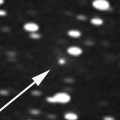
|
Now it is 13.5 mag (Apr. 25, Chris Wyatt), already visible visually. It is getting brighter rapidly in the morning sky. It keeps observable bright as 9-10 mag for a long time from spring to autumn.
Date(TT) R.A. (2000) Decl. Delta r Elong. m1 Best Time(A, h)
May 8 21 3.91 -9 57.5 1.141 1.545 91 11.5 5:15 (206, 63)
May 15 21 24.69 -9 18.9 1.076 1.519 93 11.1 5:19 (200, 63)
|
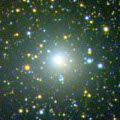
|
It reached up to 7.7 mag in last summer (Aug. 13, Chris Wyatt). It is fading now. It has already faded down to 11.7 mag (Apr. 25, Marco Goiato). In the Southern Hemisphere, it keeps observable for a long time after this. But in the Northern Hemisphere, it is only observable in the low sky in spring, then it will never be observable again.
Date(TT) R.A. (2000) Decl. Delta r Elong. m1 Best Time(A, h)
May 8 20 10.38 -34 6.4 3.811 4.251 109 11.4 5:08 (180, 89)
May 15 20 4.79 -35 39.9 3.739 4.294 117 11.4 4:35 ( 0, 89)
|
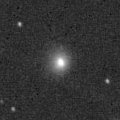
|
Bright new comet discovered as a bright stellar object of 12.5 mag on Apr. 16. It was not detected, fainter than 20 mag, on the previous day (Apr. 15, Catalina Sky Survey). It was discovered just after the sudden outburst. It is bright as 11.7 mag still now (May 2, Seiichi Yoshida). The coma is expanding up to 2 arcmin.It keeps observable good condition for a while. The coma will be expanding rapidly after this.
Date(TT) R.A. (2000) Decl. Delta r Elong. m1 Best Time(A, h)
May 8 13 24.22 4 29.6 2.218 3.122 148 12.0 22:19 (180, 51)
May 15 13 20.57 4 10.0 2.270 3.125 141 12.0 21:48 (180, 51)
|
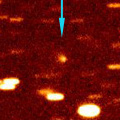
|
It brightened up to 15.5 mag in January (Jan. 31, C. Rinner, F. Kugel). It is not observable now. The condition of this apparition is bad. It will reach up to 11-12 mag from spring to autumn, but it is not observable.
Date(TT) R.A. (2000) Decl. Delta r Elong. m1 Best Time(A, h)
May 8 2 40.47 20 24.3 2.492 1.490 5 12.4 5:15 (256,-16)
May 15 3 3.78 21 18.6 2.462 1.460 5 12.3 5:19 (254,-15)
|
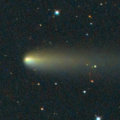
|
It brightened up to 9.5 mag on Jan. 13 (Juan Jose Gonzalez). Now it is fading rapidly. But it is still bright as 12.3 mag (May 5, Juan Jose Gonzalez). It will be observable in good condition for a long time after this in the Northern Hemisphere. It keeps visible visually until summer. In mid March, the nuclear fragmentation was observed.
Date(TT) R.A. (2000) Decl. Delta r Elong. m1 Best Time(A, h)
May 8 14 53.85 64 1.4 2.939 3.253 99 12.6 23:48 (180, -9)
May 15 14 47.80 63 47.6 3.025 3.306 97 12.8 23:14 (180, -9)
|

|
Chris Wyatt reported it was visible visually at 11.3 mag on Apr. 25. But no other observations have been reported. The condition of this apparition is very bad. It will never be observable after this.
Date(TT) R.A. (2000) Decl. Delta r Elong. m1 Best Time(A, h)
May 8 1 20.90 15 4.3 1.664 0.842 23 13.6 5:15 (250, 3)
May 15 1 59.69 17 46.0 1.661 0.798 20 13.0 5:19 (248, 0)
|

|
Now it is visible visually at 13.4 mag (Mar. 25, Chris Wyatt). It will brighten up to 12-13 mag in summer. But it locates somewhat low in the Northern Hemisphere.
Date(TT) R.A. (2000) Decl. Delta r Elong. m1 Best Time(A, h)
May 8 20 50.25 -25 11.3 2.108 2.475 98 13.1 5:15 (218, 78)
May 15 20 57.39 -25 23.7 2.033 2.483 104 13.1 5:19 (191, 80)
|

|
Great outburst up to 11 mag occured on Feb. 2. Another new minor outburst occured up to 12.7 mag on Apr. 16 (Albert Sanchez Caso). It is bright as 11.2 mag still now (May 5, Juan Jose Gonzalez).
Date(TT) R.A. (2000) Decl. Delta r Elong. m1 Best Time(A, h)
May 8 9 18.57 13 7.1 6.112 6.209 90 13.9 18:37 (173, 42)
May 15 9 20.34 12 57.3 6.225 6.210 84 13.9 18:32 (166, 41)
|
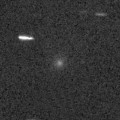
|
Bright new comet discovered at 11 mag in the extremely low sky at dawn. Now it is 10.7 mag (Mar. 27, Juan Jose Gonzalez). It was observed only about one week. It will never be observable again.
Date(TT) R.A. (2000) Decl. Delta r Elong. m1 Best Time(A, h)
May 8 3 23.52 13 31.9 1.904 0.910 6 14.0 18:37 ( 99,-11)
May 15 3 42.45 10 7.9 1.998 1.014 9 14.6 18:32 ( 95,-10)
|
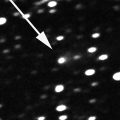
|
Now it is visible visually at 14.5 mag (Mar. 15, Juan Jose Gonzalez). It keeps observable for a long time until September when it becomes fainter than 18 mag.
Date(TT) R.A. (2000) Decl. Delta r Elong. m1 Best Time(A, h)
May 8 16 11.96 -30 23.3 0.744 1.723 158 14.7 1:10 (180, 85)
May 15 16 12.40 -29 49.2 0.738 1.734 164 14.7 0:43 (180, 85)
|
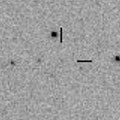
|
It was observed as 15.6 mag at the end of last year (Dec. 6, A. Maury, J. B. de Vanssay, F. Mallia, F. Kugel). It will be 14 mag from winter to spring in 2010. But the condition is bad. It had been unobservable for a while, but it is getting observable in the morning sky now. Then it keeps observable while fading gradually.
Date(TT) R.A. (2000) Decl. Delta r Elong. m1 Best Time(A, h)
May 8 1 38.20 28 16.0 2.793 1.893 21 14.9 5:15 (241, -9)
May 15 1 52.84 31 14.7 2.799 1.926 24 15.0 5:19 (237, -7)
|

|
The condition of this apparition is very bad. It will go away without any observations.
Date(TT) R.A. (2000) Decl. Delta r Elong. m1 Best Time(A, h)
May 8 4 11.32 18 44.1 2.105 1.180 17 15.0 18:37 (110, -5)
May 15 4 40.08 19 12.5 2.112 1.187 17 15.1 18:32 (111, -4)
|
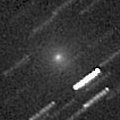
|
Bright new comet. Now it is 13.2 mag (Apr. 5, Juan Jose Gonzalez). It keeps observable in the very low sky in the Southern Hemisphere. But it will never be observable again in the Northern Hemisphere.
Date(TT) R.A. (2000) Decl. Delta r Elong. m1 Best Time(A, h)
May 8 5 33.78 7 47.9 1.950 1.325 38 15.2 18:37 (113, 18)
May 15 5 47.83 4 20.5 2.030 1.373 37 15.4 18:32 (109, 18)
|
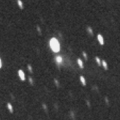
|
Now it is 15.5 mag (Feb. 20, S. Plaksa, E. Bryssinck). It is also visible visually at 14.5 mag (Apr. 10, Juan Jose Gonzalez). It keeps observable at 15 mag for a long time in 2010.
Date(TT) R.A. (2000) Decl. Delta r Elong. m1 Best Time(A, h)
May 8 18 3.52 34 13.9 4.178 4.660 112 15.3 3:02 (180, 21)
May 15 18 1.94 35 43.7 4.139 4.646 114 15.3 2:32 (180, 19)
|
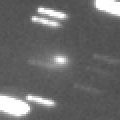
|
It became bright more rapidly than expected. Now it is 14.8 mag (Apr. 6, Catalina Sky Survey). It will be visible visually. It keeps 15 mag for a while. But it will be getting lower gradually in the evening sky.
Date(TT) R.A. (2000) Decl. Delta r Elong. m1 Best Time(A, h)
May 8 6 36.64 33 42.7 2.102 1.669 51 15.3 18:37 (143, 9)
May 15 7 1.09 33 30.4 2.155 1.690 49 15.3 18:32 (143, 9)
|
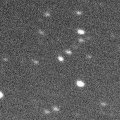
|
Now it is 15.6 mag (Apr. 11, John Drummond). It keeps bright as 14-15 mag for a long time after this until 2013. It is observable in good condition in the Southern Hemisphere. However, it is not observable in the Northern Hemisphere.
Date(TT) R.A. (2000) Decl. Delta r Elong. m1 Best Time(A, h)
May 8 15 20.09 -47 36.5 6.087 6.972 149 15.4 0:19 ( 0, 77)
May 15 15 13.36 -47 55.8 6.043 6.942 150 15.3 23:40 ( 0, 77)
|

|
Now it is 15.3 mag (Mar. 26, P. Concari, S. Foglia, G. Galli, M. Tombelli). It was observed as 15-16 mag in early 2009. In 2010, it will be observable at 16 mag in good condition from winter to spring.
Date(TT) R.A. (2000) Decl. Delta r Elong. m1 Best Time(A, h)
May 8 13 26.89 -1 50.8 2.760 3.686 152 15.5 22:22 (180, 57)
May 15 13 23.66 -1 45.9 2.815 3.693 145 15.6 21:51 (180, 57)
|
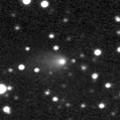
|
It became visible visually at 13.3 mag in winter (Feb. 3, Marco Goiato). Now it is fading slowly. It will be getting lower in the evening sky after this. It will be too low to observe in July.
Date(TT) R.A. (2000) Decl. Delta r Elong. m1 Best Time(A, h)
May 8 7 38.46 24 17.2 2.078 1.891 65 15.7 18:37 (150, 24)
May 15 7 55.90 23 52.0 2.140 1.898 62 15.8 18:32 (148, 24)
|
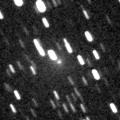
|
Now it is 15.1 mag (Apr. 3, Ken-ichi Kadota). It has a very faint large coma. It was observed so bright as 13.5 mag in January (Jan. 16, Michael Jager).
Date(TT) R.A. (2000) Decl. Delta r Elong. m1 Best Time(A, h)
May 8 9 38.13 68 41.3 1.444 1.576 77 15.8 18:37 (180,-13)
May 15 10 19.04 63 26.6 1.475 1.622 78 15.9 18:49 (180, -8)
|
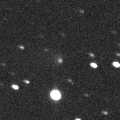
|
Now it is 16.9 mag (Jan. 9, Ken-ichi Kadota). Brightening more slowly than expected. It will be observable at 13-14 mag for a long time from 2011 to 2012. It is getting higher gradually after this. In 2010, it is observable at 15-16 mag in good condition from spring to autumn.
Date(TT) R.A. (2000) Decl. Delta r Elong. m1 Best Time(A, h)
May 8 21 59.86 1 41.0 7.506 7.308 74 15.9 5:15 (219, 46)
May 15 21 58.91 1 51.2 7.351 7.274 81 15.8 5:19 (208, 50)
|

|
Now it is 15.6 mag (Mar. 17, Toshiyuki Takahashi). It was expected to be observable at 15 mag in good condition from winter to spring. But actually, it had been much fainter than expected until January. However, it is brightening very rapidly in February.
Date(TT) R.A. (2000) Decl. Delta r Elong. m1 Best Time(A, h)
May 8 10 24.96 17 58.0 1.787 2.257 104 15.9 19:21 (180, 37)
May 15 10 31.73 16 53.8 1.867 2.263 99 16.0 19:00 (180, 38)
|
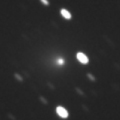
|
It brightened up to 11.5 mag in January (Jan. 12, Juan Jose Gonzalez). Now it is fading. It has already faded down to 14.9 mag (Apr. 9, E. Bryssinck, A. Novichonok, D. Chestnov). It will be getting fainter and lower rapidly after this. It will be unobservable in June.
Date(TT) R.A. (2000) Decl. Delta r Elong. m1 Best Time(A, h)
May 8 7 58.05 19 25.5 2.334 2.213 70 16.2 18:37 (152, 30)
May 15 8 11.67 19 6.5 2.429 2.236 66 16.4 18:32 (149, 30)
|

|
It brightened up to 11 mag in spring and summer in 2009. Appearing in the morninig sky again. Now it is 16.7 mag (Apr. 23, Hidetaka Sato). It keeps observable after this until autumn when it becomes fainter than 18 mag while fading gradually. But it locates somewhat low in the Northern Hemisphere.
Date(TT) R.A. (2000) Decl. Delta r Elong. m1 Best Time(A, h)
May 8 20 9.98 -24 25.3 2.431 2.902 107 16.5 5:08 (180, 79)
May 15 20 12.00 -24 29.9 2.367 2.928 114 16.5 4:42 (180, 79)
|

|
It brightened up to 13 mag and observed visually from 2007 to 2009. Due to the far distance, it is bright as 14.8 mag still now (Apr. 7, E. Bryssinck, A. Novichonok, D. Chestnov, L. Elenin). It will be getting lower in the evening sky after this, and it will be too low to observe in August. However, it will be observable in good condition again at 17.5 mag in autumn.
Date(TT) R.A. (2000) Decl. Delta r Elong. m1 Best Time(A, h)
May 8 11 55.48 42 38.7 7.774 8.127 107 16.6 20:50 (180, 12)
May 15 11 50.96 42 21.7 7.901 8.161 101 16.6 20:18 (180, 13)
|
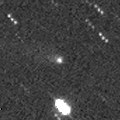
|
Now it is 16.5 mag (Apr. 17, Hiroshi Abe). It keeps observable in good condition for a while, but it will be fading after this. It will be fainter than 18 mag in July.
Date(TT) R.A. (2000) Decl. Delta r Elong. m1 Best Time(A, h)
May 8 12 20.42 25 32.8 2.934 3.580 122 16.9 21:15 (180, 30)
May 15 12 9.77 24 14.2 3.069 3.623 115 17.0 20:37 (180, 31)
|

|
It brightened up to 13 mag in major outburst in 2005. It was recovered at 20.7 mag in 2009 January. Hidetaka Sato reported that it is so faint as 20.1 mag still now (May 5).
Date(TT) R.A. (2000) Decl. Delta r Elong. m1 Best Time(A, h)
May 8 12 53.90 -20 46.4 2.385 3.299 150 17.2 21:49 (180, 76)
May 15 12 49.93 -20 10.5 2.407 3.274 143 17.1 21:17 (180, 75)
|
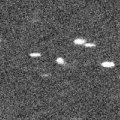
|
Now it is 17.7 mag (Mar. 21, Hidetaka Sato). It will reach up to 17 mag in spring and summer.
Date(TT) R.A. (2000) Decl. Delta r Elong. m1 Best Time(A, h)
May 8 21 4.68 -5 10.5 3.199 3.356 90 17.3 5:15 (203, 58)
May 15 21 7.43 -6 10.7 3.107 3.373 96 17.2 5:19 (189, 61)
|
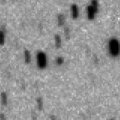
|
Now it is 17.2 mag (Apr. 10, Hidetaka Sato). It was observed at 17.5 mag in 2009 spring. It will be observable at 17.5 mag again in 2010 spring. However, it locates low in the Northern Hemisphere.
Date(TT) R.A. (2000) Decl. Delta r Elong. m1 Best Time(A, h)
May 8 13 30.64 -17 1.4 5.049 6.002 158 17.3 22:25 (180, 72)
May 15 13 28.53 -16 2.7 5.102 6.012 151 17.3 21:56 (180, 71)
|
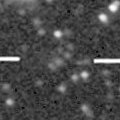
|
Now it is 17.3 mag (Jan. 23, Ken-ichi Kadota). It keeps observable at 17.5 mag in good condition for a long time in 2010.
Date(TT) R.A. (2000) Decl. Delta r Elong. m1 Best Time(A, h)
May 8 23 19.94 78 10.2 5.157 4.843 66 17.4 5:15 (189,-26)
May 15 23 15.39 79 37.0 5.154 4.845 66 17.4 5:19 (187,-26)
|
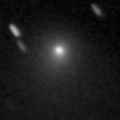
|
Now it is 17.4 mag (Feb. 17, Hidetaka Sato). It will be fainter than 18 mag in July.
Date(TT) R.A. (2000) Decl. Delta r Elong. m1 Best Time(A, h)
May 8 18 59.67 40 20.0 6.510 6.758 99 17.5 3:58 (180, 15)
May 15 18 58.05 41 4.3 6.516 6.809 102 17.5 3:28 (180, 14)
|
|
![]()
 65P/Gunn
65P/Gunn 29P/Schwassmann-Wachmann 1
29P/Schwassmann-Wachmann 1 C/2010 F4 ( Machholz )
C/2010 F4 ( Machholz ) P/2010 A5 ( LINEAR )
P/2010 A5 ( LINEAR ) 126P/IRAS
126P/IRAS 104P/Kowal 2
104P/Kowal 2 C/2010 G1 ( Boattini )
C/2010 G1 ( Boattini ) C/2008 FK75 ( Lemmon-Siding Spring )
C/2008 FK75 ( Lemmon-Siding Spring ) P/2010 A3 ( Hill )
P/2010 A3 ( Hill ) C/2009 F4 ( McNaught )
C/2009 F4 ( McNaught ) 74P/Smirnova-Chernykh
74P/Smirnova-Chernykh 30P/Reinmuth 1
30P/Reinmuth 1 C/2009 U3 ( Hill )
C/2009 U3 ( Hill ) C/2006 S3 ( LONEOS )
C/2006 S3 ( LONEOS ) 94P/Russell 4
94P/Russell 4 118P/Shoemaker-Levy 4
118P/Shoemaker-Levy 4 116P/Wild 4
116P/Wild 4 C/2005 L3 ( McNaught )
C/2005 L3 ( McNaught ) C/2008 N1 ( Holmes )
C/2008 N1 ( Holmes ) 213P/2009 B3 ( Van Ness )
213P/2009 B3 ( Van Ness ) C/2009 K2 ( Catalina )
C/2009 K2 ( Catalina ) C/2009 F2 ( McNaught )
C/2009 F2 ( McNaught ) C/2007 VO53 ( Spacewatch )
C/2007 VO53 ( Spacewatch ) C/2006 Q1 ( McNaught )
C/2006 Q1 ( McNaught )![]()





























